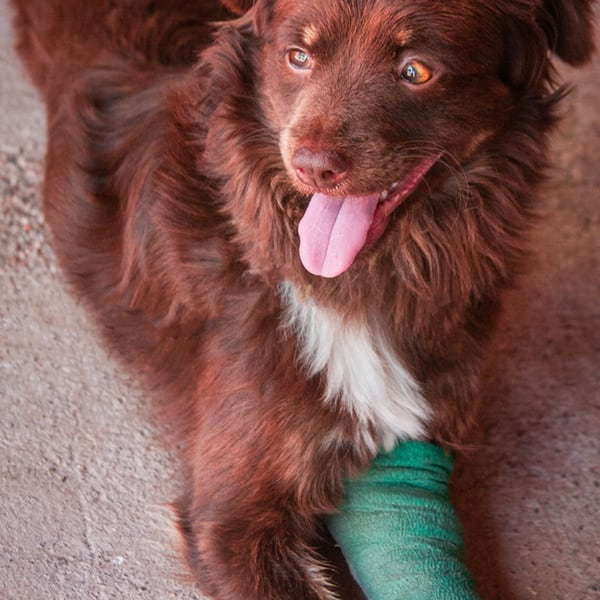Small Animal Articles
Dogs and Cats
Young Dogs and Cats

Puppy Preschool and Dog Obedience
Each year thousands of dogs end up in pounds and shelters. Many are euthanased. This is often the result of a lack of proper socialisation and training. We recommend that all dog owners and their canine friends undergo a specialised education program – the results speak for themselves. Well-socialised and educated dogs are easier to

Unlocking Dog DNA at WestVETS
Do you have a mixed breed dog? Have you ever wondered ‘where’ he or she came from? Are you curious about his/her physical and behavioural traits? Almost 50 % of dogs in Australia are a mixed breed. The smarter you are about your dog’s past, the smarter you can be about his/her future. Dogs are

Getting a Puppy or a Kitten – what to be aware of
Dogs and cats make wonderful companions. A lot of emotion is involved in choosing a pet, but don’t fall into the trap of making an impulse decision. It pays to spend a little time researching what sort of pet suits your lifestyle. That may sound funny, but this a recipe for a happy human-animal relationship.
Adult Dogs and Cats

Top Dog Health Tips
Humans have had companion animals for thousands of years. Having a dog can help people achieve health goals, such as lowered blood pressure and increased fitness, or mental goals, such as decreased stress. There is evidence that having a pet can help a person lead a longer, healthier life. If our health is a significant

Take A Serious Look At Pet Health Insurance
When it comes to budgeting, it is impossible to prepare for accidents or illness and when considering our pets, this usually means vet bills. Without government funded healthcare for our pets, medical and surgical treatments can be quite costly. Many technologies available in human medicine are now available in veterinary medicine, and with the expanding
Senior Dogs and Cats

Focus on Senior Pets
It may break your heart to see your beloved pets whiten around the muzzle, struggle to stand, or even not be able to play the way they used to, however take comfort in knowing that advances in Veterinary Medicine now help pets live longer, healthier lives. New diagnostics, better vaccines, increased parasite control, and broader

Senior Pet Care
From the age of 7 your pet’s health can change.Although your pet may still look and behave like a youngster, after their 7th birthday (or 5th birthday for large and giant breeds) cats and dogs enter their senior years. In human terms, it’s equivalent to entering your 50s. And just as our nutritional and physical

Has Fido or Fluffy Become Forgetful?
As our beloved pets get older, the ravages of age seem to creep up on us. The symptoms of old age are often not noticed until ailments are quite advanced, or pointed out by family or friends who may notice more distinct changes over time. Arthritis, loss of exercise tolerance, blindness and deafness are often

Caring For The Senior Cat
There are now more pet cats than dogs in the North America. Improved nutrition, prevention of infectious disease and advances in veterinary medical care have resulted in pets living longer and healthier lives. In North America, over the last ten years there has been a 15% increase in cats over ten years of age and
Medicating Your Pet At Home

Hidden Household Dangers
The warmer months bring not only spring flowers and summer barbeques but also hidden household dangers. Many people are unaware of the many toxic and potentially fatal household plants and foods that frequent our homes. Below are just a few dangers for your pets to avoid: These common household items and their potential danger to

General First Aid and Your Pet
Knowing some first aid for your pet when they are injured can make a huge difference in helping to make them comfortable before you can get veterinary attention. A common injury we see with dogs is when they cut their paw or damage a nail. This can often result in a lot of bleeding. Not

Applying Creams, Ointments & Lotions
Applying topical medications to your pet can sometimes be a challenge. The information provided in this handout may help make treating your pet easier – for both of you. What is the difference between creams, ointments and lotions? Creams are non-greasy. Ointments have an oily base. Lotions are liquid preparations. All are similar as far
Tips For Administering Ear Drops To Your Dog
Administering ear medications to your dog can be challenging. Remember that your pet’s ears may be painful and that even a normally gentle and passive dog may respond by struggling, biting or scratching. You may need to muzzle your dog for this procedure. Warm any refrigerated medication by placing the bottle in a bowl of
Administering Drugs By Injection
Two routine injections that have to be given by owners involve the administration of insulin in the treatment of diabetes mellitus and administering allergenic extract injections to control skin allergies. Your veterinarian will review the technique but the following questions and answers may be of help. Will the injection be painful? Most pets don’t seem
Tips For Giving Your Dog A Pill
The easiest way to give your dog a pill is to hide the pill in food. This usually works best if the pill is hidden in a small amount of canned dog food, peanut butter or cottage cheese. To ensure that the pill is swallowed, it is better to hand feed a small amount of
Tips For Giving Liquid Medication To Your Dog
The easiest way to give your dog a liquid medication is to mix it with some canned food. To ensure that the medication is swallowed, it is best to hand feed a small amount of food containing the medication, rather than a large portion that the dog may not completely consume. Some dogs may be
Preventative Care
Diet and Nutrition

Obesity in Dogs
I have been told that my dog is obese and must be put on a diet. Is this true? Nearly one-third (33%) of all adults in the United States are obese. Unfortunately, this same number now applies to our pets. Obesity leads to several diseases both in pets and people. Type II diabetes, heart disease

Managing Obesity In Our Pets – Part 1
The human animal bond we share with our pets is strong. We love to spoil them by buying them toys, cute little coats, beds (or let them sleep on our own) and worst of all feed them treats. A well rounded figure is increasingly being perceived as normal amongst many pet owners. Society has become

Managing Obesity In Our Pets – Part 2
In the August issue of The Local Bulletin we raised the topic of obesity in our pets. About one quarter of our pets are obese and many more are above optimum weight. There are numerous factors that contribute to weight gain in our pets, but put simply, overweight pets eat too much for their metabolic

The Fat and Skinny on Obesity
There is a common adage that owners with obese dogs or cats are “loving their pets to death”. And this can be taken quite literally. The extra treats or the table scraps could very well be pushing your pet towards the grave. Overweight cats are at an increased risk of arthritis, urinary tract infections, liver
Parasite Control
Be Prepared For Tick Season
Spring marks the start of Tick Season and this is proving to be one of the worst tick seasons on record. The tick season started early this year and we have seen a huge increase in tick paralysis cases in both dogs and cats. The holiday season is also fast approaching and many pet owners
My Pet has a Tick
If you see a tick on your pet, you should remove it as soon as you can and keep it for your vet to identify. You can use tweezers, specially made tick removers, or if you’re not squeamish, your finger nails. Don’t be overly concerned if some of the tick’s head is left behind, it
Common Internal and External Parasite Product Comparison
Download information sheet comparing Common Internal and External Parasite Products. Product Comparison Sheet
Vaccination
Booster Vaccines – Are They Really Necessary?
Primary vaccination is essential in order to prevent the once common puppyhood and kittenhood diseases that caused high levels of fatality from returning. However, recent research indicates that all vaccines may not require yearly booster vaccines. There is no evidence that annual booster vaccination is anything but beneficial to the majority of pets. Published research
Vaccinate And Protect Your Pets
The advent of vaccines represents one of the cornerstones of modern medicine. There is no question that vaccines control diseases which produce significant morbidity and mortality in our pets and livestock. We now enjoy relatively low incidence of diseases which were once common place, and as such, it is easy to become complacent about many
Dental Care
Pets Need Dental Care Too
When did you last see a dentist? Many of us will often neglect a regular visit to the dentist while trying to schedule our busy lives, but have you ever spared a thought for your dog or cat? Sadly, pet dental hygiene is often overlooked until their gum disease is well and truly advanced and
Seasonal Healthcare for Your Pet
Summer Pet Care
It is fair to say that the weather this summer has been extreme – excessive heat followed by excessive rain and fierce storms. Despite these changing weather systems, summer is a wonderful time for sharing the outdoors with your pets. By following a few pet safety tips, you can keep your animal friends healthy while
Beware Cold & Flu Remedies
In the midst of Winter, the rivers of sneezes herald the flu season. The viruses that cause these ailments in humans are highly contagious to other people but do not affect cats and dogs. However, the medications that we take to relieve our symptoms can result in lethal side effects if ingested by our pets.
Look Out! Snakes are About
With the warmer weather and the drier conditions, snake sightings have risen dramatically, as too have the cases of snake bite cats and dogs. In the past month alone, we have treated more than 10 incidences of snake bite. Local community development has resulted in built-up residential areas spreading into what was once native bush
A Warm Winter Reminder
It is that time of the year again. For many of us, winter brings aches and pains, and your companion animals also feel these ailments. Help is close by. You may notice your dogs slowing down and having difficulty getting up particularly after resting. Those lucky dogs that travel can have difficulty jumping into the
Keeping Warm during Winter
Does your dog have trouble getting up in the morning and seem a bit stiff? Unfortunately, arthritis can be a real pain in the neck….. hip, elbow or back. Pains, stiffness, reluctance to exercise or to perform normal manoeuvres such as jumping into the car are common signs of arthritis. Rarely will your dog show
Summer Hazards and Christmas Treats
Some readers may have heard the following before but we often find that a reminder never goes astray. Not only does Summer bring good times but it also brings some dangers for your pets. Ticks are back. We are seeing huge numbers of pets affected by paralysis ticks and prevention truly is better than cure.
Common Conditions
Musculoskeletal Disease
Battling Arthritis – the facts
It is estimated that 20% of middle-aged dogs and 90% of older dogs experience the pain of osteoarthritis in at least one joint in their body. This disease can be both crippling and painful. Proper management can offer hope for treating and preventing the disease. The pain and stiffness commonly called ‘arthritis’ can be one
Dust off old Chewy….I’m back!!
As most people are aware, arthritis is a painful condition in both people and pets. Traditionally arthritis has been treated with a combination of therapies including pain relief, anti-inflammatories and medications such as cartrophen and glucosamine. At Anstead Veterinary Practice we have recently added a new weapon to the arsenal. After intensive training we have
Cranial Cruciate Ligament Disease
This information sheet is provided to you to give you all the information you need to understand what a diagnosis of cruciate ligament disease means for you and your dog. It is one of the most common causes of lameness that we see in dogs and fortunately there is a lot that we can now
Degenerative Joint Disease
As our pets age, the tissues lining the bones and joints may deteriorate and degenerate. Degenerative Joint Disease (DJD) describes chronic arthritis or osteoarthritis which is a gradual deterioration of articular cartilage within the joints. What is DJD? Joints consist of a tough fibrous joint capsule joining the bones. The joint capsule is lined by
Skin and Ears
Pyoderma
What is pyoderma? Pyoderma is defined as a bacterial skin infection. It comes from the Greek words pyon meaning “pus” and derma meaning “skin”. Pyoderma may also be referred to as impetigo, especially in puppies. What are the clinical signs of pyoderma? The most common clinical signs associated with pyoderma are papules or pustules that
Sarcoptic Mange
What causes sarcoptic mange? Sarcoptic mange is caused by a parasitic mite that burrows just beneath the surface of the skin, Sarcoptes scabiei. The mite feeds on material in and on the skin. It is also known as scabies and is a zoonotic disease or a disease transmissible from pets to people. What does it
Ear Mites
The ear mite Otodectes cynotis is a surface mite that lives on cats, dogs, rabbits and ferrets. It is usually found in the ear canal but it can also live on the skin surface. The entire ear mite life cycle takes place on animals. Cats become infested by direct contact with another infested animal. The
Flea Allergy Dermatitis
My dog’s skin has always been itchy and every summer he has to be treated. Recently, he underwent a lot of tests and I have been told that he has flea allergy dermatitis. The problem is that I have never seen a flea on him. Is this diagnosis correct? Flea allergy dermatitis (FAD) is the
Allergy
What is an allergy? An allergy is a state of over-reactivity or hypersensitivity of the immune system to a particular substance called an allergen. Most allergens are proteins. The allergen protein may be of insect, plant or animal origin. Initial exposure of the dog, or more likely multiple exposures, to the allergen may over-sensitize the
Eyes
Feline Herpesviral Conjunctivitis
What is feline herpesviral conjunctivitis? Conjunctivitis is a medical term used to describe inflammation of the tissues surrounding the eye. These tissues include the lining of the lids and the third eyelid as well as the tissues covering the front part of the eye or globe. Conjunctivitis may be a primary condition (caused by an
Corneal Ulcers
What is a corneal ulcer? The cornea is the transparent, shiny membrane which makes up the front of the eyeball. Think of it as a clear window. To understand a corneal ulcer, you must first understand how the cornea is constructed. The cornea is composed of three layers. The most superficial layer is the epithelium,
What is a cataract?
Inside the eye is a lens that focuses light on the back of the eye or the retina. Vision occurs at the retina. The structure of the eye is similar to a camera, which has a lens to focus light on the film. If the lens becomes opaque this is called a cataract. What causes
Heart and Lung Disease
Feline Cardiomyopathy
What is cardiomyopathy? Cardiomyopathy is a term used to describe diseases of the heart muscle. In cats, three classes of cardiomyopathy have been described: hypertrophic, dilated and intermediate or restrictive cardiomyopathy. In all classes, the heart disease usually results in clinical signs of heart failure. Cardiomyopathy may be seen as a primary condition or secondary
Urinary Disease
The Important Warning Signs Of Diabetes In Your Pets
Many of us have some knowledge of diabetes. What you may not know, is that it happens to be one of the most common metabolic conditions affecting dogs and cats. Sometimes referred to as ‘sugar diabetes’, it occurs when there is a deficiency or lack of response to the hormone insulin. This results in cells
Hormonal and Viral Disease
Be On The Lookout For A Sinister Cat Killer
Feline immunodeficiency virus or FIV is an all too common and insidious virus affecting our feline companions. FIV is closely related to the human AIDS virus, hence it is commonly referred to as Feline AIDS, and while it has many similarities, it is not infectious to people. This virus is usually transmitted by deep bite
Hypothyroidism
What is the thyroid gland and what does it do? The thyroid gland is one of the most important glands in the body. It is located in the neck near the trachea or “windpipe” and has two lobes, one on each side of the trachea. This gland is controlled by the pituitary gland, which is
Dental Disease
Dental Disease in Cats
How common is dental disease in cats? Dental disease is one of the most common conditions seen by veterinarians. Approximately two-thirds of cats over three years of age have some degree of dental disease. The most common problems are due to periodontal disease, gingivitis and cervical neck lesions, also called oral resorptive lesions. What are
Gastrointestinal Disease
Canine Pancreatitis
What is pancreatitis? The pancreas is a vital organ which lies on the right side of the abdomen. It has two functions: When the pancreas becomes inflamed, the disorder is called pancreatitis. It is a disease process that is seen commonly in the dog. There is no age, sex, or breed predisposition. There are two
Constipation in Cats
What is constipation? Constipation can be defined as an abnormal accumulation of feces resulting in difficult bowel movements. This may result in reduced frequency or absence of defecation. The feces are retained in the large intestine or colon. Since one of the major functions of the colon is water absorption, the retained feces become hard
Other Pets
Pocket Pets
Rats as Pets
A rat could be the perfect addition to your family if you have limited space, don’t want the long term commitment of a dog or cat, or simply if you want to enjoy the pleasure of owning a pocket pet. Rats are intelligent, curious animals that can make wonderful pets, living on average 2-3 years.
Pocket Pets
When considering what sort of animal to buy for your next pet, maybe you should consider a ‘pocket pet’. While here in Queensland the type of pocket pets we can keep is limited by law, the rats, mice and guinea pigs that we can legally keep make great pets. Rats are often thought of as
Birds
Something to Crow About
Keeping a few chickens in the backyard is not only pleasurable but can be beneficial to your kitchen and gardens. One of the most common reasons for keeping pet hens is their ability to provide a daily source of fresh nutritious free range eggs. Hens typically start laying around 18-20 weeks of age, although this
